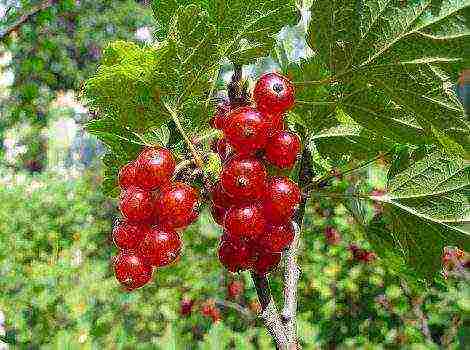Content
- 1 Varietal variety of cucumbers
- 2 The most popular varieties with names
- 3 How to choose the right seeds for open field cucumber?
- 4 How to prepare cucumber seeds for outdoor planting?
- 5 How to plant seeds?
- 6 Two ways of sowing cucumbers - take note of both!
- 7 What are the best cucumber seeds - the opinions of gardeners
- 8 Cucumber seeds - the purpose of varieties
- 9 Variety selection
- 10 Varieties of greenhouse cucumbers and their descriptions
The success of the cucumber crop depends in particular on the choice of seed. The wide assortment on the shelves confuses thoughts rather than allows you to make the right decision. Novice gardeners are advised to first familiarize themselves with the varieties, their names, the characteristics of cultivation and care.
Depending on climatic conditions, different varieties can be planted in Ukraine, Belarus, Chernozem, Bashkiria and the middle lane - these can be parthenocarpic, early ripening, with a long ripening period, or delicious cucumbers for growing in a greenhouse. More information is structured in the article in the form of a kind of list-rating.
Varietal variety of cucumbers
A large number of varieties allows you to choose the best options that have disease and weather resistance the region where the green plant is planned to be grown.
A common mistake is the use of certain 2-3 varieties, the cultivation of which has been practiced for several decades.
Domestic and foreign breeders have developed many hybrids that have no less affordable agricultural technology and excellent taste than the once loved cucumbers.
Among the top tips for growing vegetables, experts point to the need to plant several varieties at once... This makes it possible to evaluate the yield of different species under the same ripening conditions, to get at least some yield during drought or prolonged rains.
Collect the necessary and useful information about the varietal variety, the characteristics of the characteristics of zelents can be found below.
The most popular varieties with names
For the convenience of perception and application of the text in practice, plants are divided into separate groups, united by a common feature.
The best self-pollinating for outdoor use
Self-pollinating cucumbers have a number of advantages, among which excellent immunity and resistance to an abundance of moisture are noted.
- Booth - ripening period is only 40 days. In length, the green plant reaches 9 cm. One bush yields up to 3.5 kg. The strong immunity of the plant resists various diseases (olive spot, mosaic, powdery mildew).
- Courage - harvesting of the Kurazh variety begins 40-47 days after the sprouts break through from the soil. The weight of one cucumber reaches 170-180 gr., Up to 10 zelents are formed on one shoot. The plant practically does not suffer from rot, powdery mildew.
- Connie - harvesting of fruits begins on the 50th day after sowing. The culture is universal both in the way of cultivation and in the use of cucumbers. The length of the greenery is 10 cm, the yield from 1 m2 is about 9 kg.
- Berendey - fruits (12-15 cm) ripen 42 days after the sprouts appear. One bush can be harvested up to 3.5 kg.Zelentsy have excellent characteristics and have a long shelf life.
- Gerda - fruits 10 cm long appear 1.5 months after sowing. 2.8-3 kg are removed from the bush. The plant is rarely affected by diseases; it is especially resistant to fungal infections.
The best early ripe cucumbers
Early ripening varieties have a feature that every gardener should be familiar with.
The ovaries of male flowers are the first to form, they must be removed, since they interfere with the development of the plant.
- April - from the moment of planting, the fruits of April ripen on day 50, reaching a length of 20-22 cm. The plant itself regulates the growth of shoots, so the need for pruning disappears. Productivity from 1 m2 on average 22 kg. Cucumbers do not overripe if they miss the assembly deadline. The culture is resistant to almost all diseases, with the exception of root rot.
- Hermann - sprouts at 39-41 days after sprouting. The length of Herman's greens reaches 10 cm, 23-26 kg are harvested from 1 m2. The hybrid is characterized by a long fruiting period, self-pollination and immunity to fungi.
- Orlik - begins to bear fruit on the 47-50th day after sowing. The length of the greenery reaches 14-16 cm, with a diameter of 3.5-4 cm. 6-8 kg are removed from the bush. The culture has a strong immunity, resists powdery mildew, root rot, olive spot and TMV.
- Valdai - the bush begins to bear fruit on the 45th day after the emergence of sprouts. Flowers are formed predominantly by women, therefore pollination by bees is required. The length of the greenery is about 10-11 cm, up to 4.5 kg of the crop is removed from the bush. The hybrid was developed for preservation, but due to its delicate taste it is also used for salad.
Mid-season
Medium ripening varieties begin to bear fruit on the 45-55 day after sowing the grains into the soil. All plants of this group differ in the method of cultivation (greenhouse, soil), purpose (fresh or for salting) and the type of pollination.
- Competitor - characterized as a plant that loves life and is resistant to diseases. The length of the greenery reaches 9-12 cm with an average weight of 100 grams. Up to 3.8 kg of the crop is harvested from each m2. The variety has good immunity and is resistant to powdery mildew.
- Nezhinsky - a variety pollinated by bees, characterized by a powerful stem, medium-sized fruits (length 10-12 cm, weight 90 g) and high yield (8 kg per 1 m2). Nezhinsky tolerates low temperatures and is resistant to many diseases. Cucumbers have a high taste.
- Libella - a versatile hybrid with a long fruiting period. With proper care, you can harvest until the coldest days. The length of the Libelle greenery reaches 14 cm, weight - 140 grams. Up to 10-12 kg are removed from a square meter. When salted, the flesh remains crispy and firm. In agricultural technology, there are rarely cases of damage to crops by common diseases.
- Table - has an excellent taste without bitterness, ideal for salting. The bush is formed long with a strong whip, the length of the fruit reaches 12 cm and weighs 80-90 grams. Productivity from 1 m2 about 8 kg.
Late ripening
A feature of late-ripening cucumbers is that the seeds germinate well only in the 3rd year.
Therefore, the purchased material before planting is worth check for germination... Also, when choosing varieties of this group, you need to take into account the climate of the region and the ripening period of zelents in order to have time to collect most of the harvest before the onset of cold weather.
- Phoenix - the harvest period begins 64 days after seed germination. Cucumbers reach a length of 16 cm, with an average weight of 230 g. Phoenix bushes form a branchy whip that resists the vagaries of the weather well.
- Winner - differs in long spreading lashes that easily tolerate drought, coolness. The plant is resistant to various types of fungi. Fruit length reaches 14 cm with an average weight of 110 grams. The yield from 1 m2 is 7-8 kg.
- Solar - the variety is mid-season, but most gardeners plant it as late. The bush produces many twigs, forming a massive whip, which implies planting in a large area. The peel of the greenery is covered with a few tubercles and greenish stripes. The length of a cucumber reaches 12 cm with an average weight of 140 grams.
- Brownie - the harvesting period begins 65 days after germination. The length of the cucumbers is small (9 cm), but the taste is high. The culture has good immunity, showing resistance to almost all common diseases. Productivity - 6-8 kg per 1 m2.
- Chinese - a disease-resistant variety with a mild taste and lack of bitterness. A feature of the fruit of the Chinese cucumber is considered to be a short shelf life after harvest. Original elongated cucumbers (30-35 cm) look like snakes. The plant tolerates low temperatures and poor lighting well.
Which are the highest yielding for greenhouses
All gardeners, without exception, are attracted by high-yielding varieties. In your greenhouse, you can try to grow the most popular ones.
- Parisian gherkin - fruits ripen in 50-60 days after sowing. The length of the Parisian gherkin variety reaches 12 cm with an average weight of 85 grams. A large number of ovaries are formed on the lash, which guarantees a high yield - over 30 kg per 1 m2. Low germination of seeds provides for planting beds through seedlings.
- Fontanelle - a popular cucumber among gardeners in our country. It is grown in almost every area. The dimensions of the Spring greens reach 22-24 cm with an average weight of 150 grams. More than 10 kg are removed from the bush. In terms of taste and rules of agricultural technology, the variety remains competitive in front of the best European developments of breeders.
- Zozulya - the harvesting period begins on the 45th day after sprouting. The formation of the lash is carried out in such a way that the bush does not need pruning. Zelentsy reaches 24 cm in length with an average weight of 280-300 grams. From a square meter, you can collect up to 30 kg of Zozulya cucumber. The plant is practically not sick with olive spot and cucumber mosaic.
For planting outdoors
- Suzanne - a versatile crop that can be grown not only in the open field, but in a greenhouse and even on a balcony. The length of the lash reaches 3-4 m, forming a large number of ovaries. Picking 3-4 centimeters fruit or wait until they become larger, this does not affect the taste. Suzanne has good disease and pest resistance.
- Sparta - the hybrid is bee-pollinated with stable fruiting. The length of the greenery is 6-12 cm, the taste is pleasant without bitterness. The culture has a strong immunity, especially against powdery mildew and fungi. The yield per bush is 2.8-3.1 kg.
- Pickle - the fruiting period begins 55 days after the emergence of sprouts. The length of the greens is 9-11 cm with an average weight of 100-110 grams. More than 4 kg are removed from one bush. The pickle has a delicate taste with a sweetish note, without bitterness.
- Pinocchio Is a self-pollinated hybrid that begins to ripen 48 days after germination. The length of the greenery is about 8-9 cm with a weight of 85 grams. The yield per bush is 3.4 kg.
- Sturdy - by the rate of ripening, the cucumber is considered a sprinter, just 38 days after the emergence of sprouts. The length of the greenery is about 9 cm with a weight of 80 g. The fruiting period is fleeting, all ovaries form and ripen together. Unfavorable weather does not have a negative effect on the growing season.
For growing in Siberia
Growing cucumbers in a harsh climate has its own characteristics. It is better to plant cucumbers in Siberia in polycarbonate greenhouses or choose fruitful early maturing varieties.
When choosing seeds, preference should be given to varieties that are resistant to stress.
- Altaic - it has a short ripening period, the harvest begins 36-40 days after germination. The length of the greenery is 9-12 cm with a weight of 100 g.The plant is cold-resistant, easily tolerates the vagaries of the weather. After harvesting, the fruits retain their presentation and taste for a long time.
- Serpentine - gherkin type cucumber, ripens 39-42 days after germination. The fruiting period is intense, already in the first 10 days most of the harvest is harvested - over 1.7 kg per 1 m2. Serpentine is known for its taste, which lacks bitterness.
- Bush - a compact plant that needs pollination. The length of the greenery reaches 8 cm with a weight of 90 grams. Productivity is stable with proper care (3 kg per bush). The peculiarity of the variety is its endurance and strong immunity. Cucumbers are versatile.
Each variety of cucumbers has a range of impressive benefits. The main thing when choosing is to take into account the climatic features of the region and the correspondence to them of the characteristics of the varieties you like. Then the main stage of laying the future harvest will be performed correctly.
To get a high yield, fertilized soil and constant maintenance are not enough. It is also necessary to pick up quality seeds. What kind of cucumber to plant outdoors? What should a summer resident know about preparation and planting and how to choose the right cucumber seeds for open ground?
Of the hybrids that are great for open ground, it is worth noting the following varieties:
- Eliseevsky;
- Arkhangelsky;
- Novgorodets;
- "Leader";
- "Well done";
- "Paratunka";
- "Road";
- "Take a walk";
- "Boyfriend";
- Twixy;
- "Mikhalych";
- "Gypsy";
- "Passat";
- "DF Svyatoslav".
The cucumber variety "Advance" (pollinated by bees) also gives a good yield, but it is not suitable for salting. A hybrid "Svyatoslav" can be planted especially for this.
How to choose the right seeds for open field cucumber?
In order not to miscalculate with the variety, it is worth paying attention to whether it is intended for cultivation in greenhouse conditions, on covering soils or in open soil. After all, for example, sown greenhouse types of cucumbers will not be productive in open soil.
How to choose the right seeds for open field cucumber? - It is worth determining the goal - to grow gherkins, cucumbers for pickling and pickling or salads.
Salad cucumbers will be perfectly stored in the refrigerator, they may darken a little, but when salted they will simply turn sour. Salted varieties are strong, remain crisp and green in brine. Gherkins are a good choice for both salad and canning.
Breeders have developed universal varieties that have all of the listed properties:
- Santana F1;
- Regina F1;
- Dachny;
- Crane F1;
- Gracious;
- Farmer.
If you want to feast on canned cucumbers, you should opt for:
- Nezhinsky variety;
- Muromsky (early ripening old variety);
- Fontanelle;
- Magnificent;
- Salting;
- Swag F1;
- Atlantis F1.
Among the gherkins, preference should be given:
- "Nunhems".
- Sparta F1.
- Hector F1.
- Delpine F1.
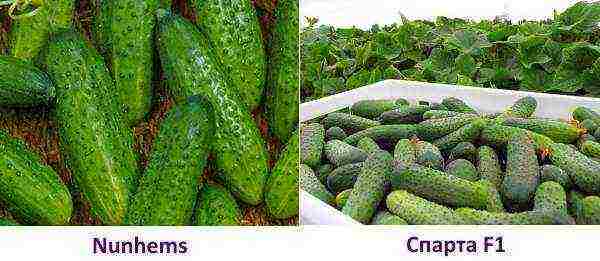

What are the pick-up seeds of cucumbers for open ground (self-pollinated) and what is the advantage of such varieties?
- The fruits are set without pollination by bees.
- They give high yields.
- They are characterized by high-quality greens.
- Cucumbers have no bitterness.
- They bear fruit constantly.
- They are characterized by high resistance to weather changes, as well as to diseases.
Self-pollinated cucumber seeds are popular, such as:
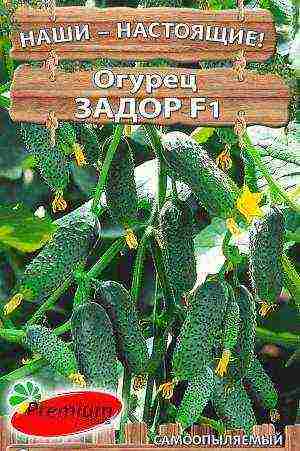 F1 Zador - dark green gherkins grow with whitish pubescence, have a cylindrical shape, length up to 10 cm. The variety is early and suitable for canning, since it has a thin skin. There are no seeds, which prevents the formation of voids during salting. You can grow by sowing in open ground or planting seedlings.
F1 Zador - dark green gherkins grow with whitish pubescence, have a cylindrical shape, length up to 10 cm. The variety is early and suitable for canning, since it has a thin skin. There are no seeds, which prevents the formation of voids during salting. You can grow by sowing in open ground or planting seedlings.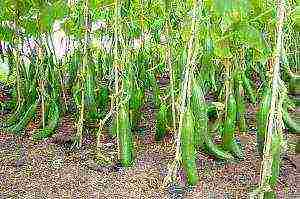 F1 Picas - these seeds give a high yield. It is a mid-season variety (55 days). If planted in open ground, the first time is covered with a film. Fruit length - up to 20 cm, weight - 200 grams.
F1 Picas - these seeds give a high yield. It is a mid-season variety (55 days). If planted in open ground, the first time is covered with a film. Fruit length - up to 20 cm, weight - 200 grams.
It is characterized by resistance to rot and powdery mildew.
It is not suitable for salting, but for a salad it is a great option. Raphael F1 is a high-yielding mid-season variety (50 days) with a shoot length of up to 3 m. Seeds are sown in May and seedlings are planted in June. One knot can contain 2 ovaries. The cucumber reaches a length of 20 cm. Not suitable for pickling.
Raphael F1 is a high-yielding mid-season variety (50 days) with a shoot length of up to 3 m. Seeds are sown in May and seedlings are planted in June. One knot can contain 2 ovaries. The cucumber reaches a length of 20 cm. Not suitable for pickling.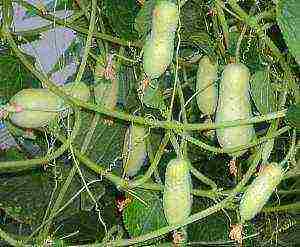 White Angel F1 is a mid-season variety characterized by a high level of self-pollination. The bosom of each leaf can contain 2 ovaries. Fruit - up to 8 cm, has infrequent tubercles. Suitable for salad and pickling. Up to 4 kg of cucumbers can be harvested from one bush. It bears excellent fruit at a temperature of 18 - 24 degrees.
White Angel F1 is a mid-season variety characterized by a high level of self-pollination. The bosom of each leaf can contain 2 ovaries. Fruit - up to 8 cm, has infrequent tubercles. Suitable for salad and pickling. Up to 4 kg of cucumbers can be harvested from one bush. It bears excellent fruit at a temperature of 18 - 24 degrees.
How to prepare cucumber seeds for outdoor planting?
Before preparing cucumber seeds for sowing in the open field, it is worth figuring out how to choose them.
- To achieve a plentiful set of cucumbers, you need to plant seeds that are at least and no more than two to three years old. Seeds can sprout in 10 years, but the yield will be minimal, just like when planting annual seeds.
- If you only have planting material that is no more than a year old, proper preparation of seeds for planting in open soil is a prerequisite to guarantee a high yield. A prerequisite for storage is to provide access to heat (for example, near a battery). 30 degrees will be enough. On the eve of the summer season, the seeds are heated at a temperature of 50 degrees for 3 hours.
- Seeds 2 - 3 years old should be stored in cloth or paper bags in a warm place with minimal moisture.
- For planting, the seeds need to be prepared. To do this, they are soaked in water for 2 hours, calibration is carried out (40 g of salt is mixed per 1 liter of water), where they are kept for about 20 minutes. Further, full-weight seeds are selected, and the weak ones are thrown away.
Then they are warmed up: in a cloth bag, the seeds are dipped for a couple of hours in a thermos, the water in which should reach 50 degrees.
How to prepare cucumber seeds for outdoor planting to prevent the development of diseases and fungi?
- It is worth disinfecting with potassium permanganate for half an hour, after which the seeds are washed. Processing can be dry or wet. If you chose the second method, then after the procedure it is worth drying the planting material.
- The next stage - the seeds are enriched with useful substances. To do this, they are immersed in a solution of wood ash (2 tablespoons of ash per 1 liter of water at room temperature) for 3 hours. Then washed again.
- To speed up the germination of seeds and protect them from rot, they are soaked in a solution of 1 tsp. copper sulfate and nitrophoska for 12 hours. To improve the immunity of the fruit, the seeds are soaked in a solution of aloe juice and water (1: 1). Another option for hardening is to place the germinated seeds in the cold for a couple of days.
- The processed seeds wrapped in a damp cloth or bag will root after 2 days. Do not wait for a large root to grow back, or it may break off when disembarking.
How to plant seeds?
First, the seeds are tested for germination. To do this, they are immersed in cool water for 12 hours, which is periodically changed. Then the seeds are taken out onto a damp cloth. It is necessary to provide conditions for germination - light, temperature and humidity should be optimal.
When the seeds begin to germinate, it will become clear which are suitable for sowing and which are not.
Prepare your garden before planting cucumber seeds outdoors. If you plan to plant seeds without further replanting, then drill sowing is used. Then you should follow these steps:
- Deepen the bed with a hoe (5 cm).
- Seeds are sown into the grooves, leaving approximately the same distance between them (which will depend on the selected variety).
- The soil is tamped and watered.
Cucumbers do not like the cold, so it is worth planting seeds in warm soil on the sunny side of the site, where there are no winds. To protect the soil from drying out (and therefore to provide favorable conditions for seed germination), it is worth covering the ground with a film.
If you plant seedlings, you will get the harvest a couple of weeks earlier.For breeding seedlings, substrates that contain peat are used.
Top dressing is carried out at the root of the sprout. Use non-concentrated water-soluble mineral fertilizers every 7 days. You can water with water at room temperature.
This review of the best open field cucumber seeds will help you get high yields even from a small planted area, since you can't go wrong with the variety you choose.
Video about choosing seeds for open ground
Foreword
Every gardener tries to grow a good harvest of cucumbers, because a lot of them are spent on conservation and fresh consumption. An important role in the yield of this vegetable is played by its variety. What are the best cucumber seeds, we will consider in this article.
Two ways of sowing cucumbers - take note of both!
Before planting cucumbers in open ground, you need to take care of creating conditions that will favorably affect the growth of vegetables. The best temperature for sowing cucumbers is 18-24 degrees. If at the time of planting the seeds there is still no such temperature, we cover the future beds in advance with ordinary plastic wrap. Thus, the soil should be properly warmed up for 10 days before sowing the seeds.
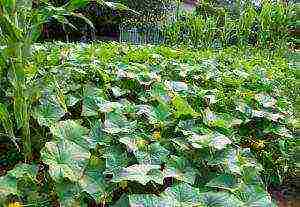
The sowing itself can be carried out in two ways: nest and row. The ordinary method involves planting seeds in several rows. The distance between seeds should be at least 10-15 centimeters. Later, when the plants grow up, you will need to remove the weak and thus increase the distance by 20-30 centimeters. The nesting method of sowing cucumber seeds is planting seeds in a hole. You can put 5-6 pieces in it. The distance between the seeds should be at least 20 centimeters so that the grown plants do not interfere with each other.
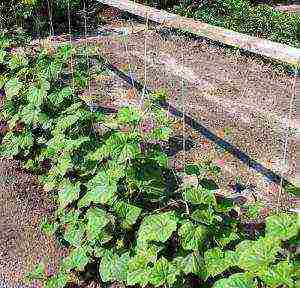
What are the best cucumber seeds - the opinions of gardeners
The question of which seeds of cucumbers are best to plant was asked by any novice gardener. And experienced ones answer that the choice of a variety depends on the conditions in which these vegetables will be grown. After all, each variety has certain advantages. Among the cucumbers planted in open ground, gardeners prefer the following varieties: "Farmer", "True Friends", "Lord". They are considered the most productive and belong to the category of bee-pollinated.
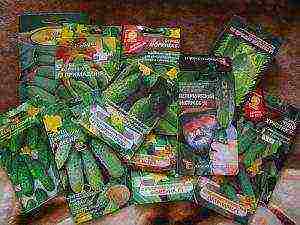
If there is a need to increase pollination, it is recommended to purchase colored seeds from which the pollinator plant grows. What are the best cucumber seeds for greenhouses? For these conditions, varieties that produce fruits without pollination (parthenocarpic) are better suited. Among these varieties of seeds are: "Marathon", "Relay", "Manual", "Northern Lights", "Olympiada" and "Ladoga".
Parthenocarpic seeds especially need favorable conditions for growing, since any stress on the plant reduces the formation of ovaries.
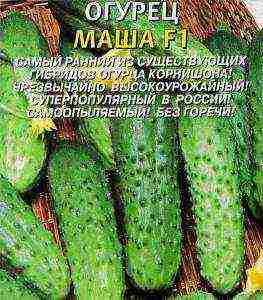
Cold-resistant varieties include cucumbers, adapted to sudden changes in temperature, to low air humidity. These are especially suitable for the climate of Siberia. The best varieties of cucumbers in this category are: "Buyan", "Boy with a Thumb", "Balalaika", "Three Tankers", "Kozyrnaya Karta", "Saltan".
Cucumber seeds - the purpose of varieties
Cucumber varieties, in addition to the type of cultivation, are also distinguished by purpose. They are divided into pickling, salad, universal and canned food. For pickled varieties, thick skin is characteristic. The fruits are saturated with sugars and pectin substances. What are the best pickled cucumber seeds? These are "Anyuta", "True Friends", "Saltan" and "Buyan". They have a fairly high yield.
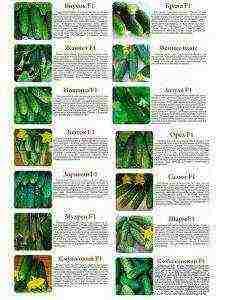
For salad cucumbers, smooth fruits are characteristic, often lumpy, with an average size. They have a sweetish taste, do not contain any bitterness.... A particularly attractive quality is their crispy flesh. The best among salad cucumbers are Makar, Zozulya, Bazar, Bukhara and Tamerlane.Experienced gardeners recommend planting several varieties at once - even if some one does not meet your expectations, his neighbors in the garden will certainly delight with the harvest.
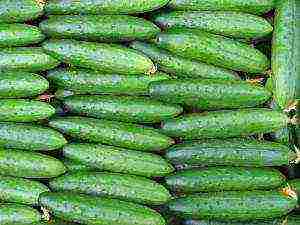
Rate the article:
(1 vote, average: 4 out of 5)
To choose for yourself 3-4 suitable greenhouse varieties of cucumbers, you must first clarify the selection criteria. To create the most complete classification of greenhouse cucumbers, you need to remember what they are.
The best varieties of cucumbers
Table. Classification of cucumbers according to various characteristics.
| Grade | • Varietal; • Hybrids |
| Pollination method | • insect pollinated; • Self-pollinated; • Non-pollinated (parthenocarpic). |
| Ripening rate | • Early maturing; • Mid-season; • Late ripening. |
| Dimensions (edit) | • Short-fruited; • Medium-fruited; • Long-fruited. |
| Method of use | • Salad; • Salting; • Universal. |
Varietal
Cucumbers from varietal seeds inherit the characteristics of the variety with further seed reproduction. From them you can collect seeds and sow again, continuing the tradition. Once every 5-7 years, the planting still needs to be completely renewed.
Why varietal cucumbers are good for a greenhouse
How to collect cucumber seeds
Hybrids
Derived from varieties, varietal characteristics do not transfer. For sowing, you need to purchase new seeds annually. Compared to varieties, they are more resistant to diseases, they are distinguished by a friendly and abundant yield in any weather and conditions.
Why hybrid cucumbers are good for a greenhouse
Greenhouse varieties of cucumbers
Insect pollinated
They are not often used for greenhouse cultivation, because in order to attract insects to the greenhouse, you need to work hard - plant attractive plants for them, arrange sweet baits, spray borage with honey syrup, open doors and windows, or temporarily remove shelter.
Pollination of cucumber
Insect pollinated cucumber varieties
Self-pollinated
They are the golden mean, since they do not need insects for pollination and do not need anyone at all. They have flowers with stamens and pistils (they combine male and female characteristics), so they cope with pollination on their own without assistance.
Hermaphrodite cucumbers
Non-pollinated
Parthenocarpic cucumbers are often confused and even called self-pollinated. But they are non-pollinated at all. Their female-type flowers are arranged in such a way that they can set fruits without pollination. One caveat, there are no seeds in the fruits of parthenocarpic varieties. That is, the situation with them for further reproduction is even worse than with hybrids.
Early ripe
Ripen in 40-45 days. They give the earliest harvest, which disappears quickly.
Mid-season
Ripen in 45-50 days. Fruiting takes longer, you can harvest fruits almost throughout the middle of summer.
Choosing cucumber seeds
Late ripening
Ripen within 50 days. Early autumn fruiting. In some areas, they may not have time to ripen, especially when sown in the ground. In greenhouses, they are grown from ready-made seedlings.
Short-fruited
These include two autonomous types of cucumbers - gherkins and pickles. They are characterized by the size of the fruits, the first - 4-9 cm, the second - 3-5. Some summer residents prefer to pick vegetables from borage at the stage of greenery, if they need short-fruited products. But this is impractical, since the yield of short-fruited varieties is much higher than zelents of normal size. The palatability of the original short-fruited varieties is also higher.
Short-fruited cucumbers
Medium-fruited
They are characterized by a size of 10-15 cm. The varieties with medium-sized fruits that fit into this range include the lion's share of all existing varieties.
Long-fruited
This category includes all cucumber plants, the fruits of which, at the stage of full consumer maturity, exceed the 15-centimeter line. There are varieties of long-fruited cucumbers, the fruits of which grow up to one and a half meters in length.
Long-fruited cucumbers
Salad
The method of consumption is usually indicated on the seed bag. And if varieties for canning can still be somehow used in the stage of technical ripeness for fresh salads, salad cucumbers cannot be canned. When salted, they will become soft or empty, they will not stand for a long time.
Advice! If there is no information on the package, you can determine the purpose of the fruit by the color of the thorns and skin. White thorns, light dense skin - salad.
Salad cucumbers
Salting
Black, brown thorns, dark thin skin - salted. Salt hardly penetrates through the dense skin of salad cucumbers, so preservation fails.
Pickled cucumbers
Universal
There are varieties "both yours and ours." They are eaten fresh and can be perfectly preserved. Their skin is of medium thinness, the thorns are gray. They are designated as generic. You can safely purchase these seeds if you equally like to feast on fresh cucumbers and crunch pickled ones.
The best varieties of cucumbers for greenhouses
For growing in a greenhouse, the most suitable:
- hybrids;
- self-pollinated or not requiring pollination;
- universal use;
- early and medium ripening;
- medium-fruited or short-fruited.
Here it is - the perfect cucumber of our time. What varieties, suitable for these parameters, characterized by high resistance to diseases and good yields, do the breeders offer.
Variety selection
Every gardener, owner of a greenhouse, dreams of growing such cucumbers so that you can get a good harvest with minimal effort, time and material resources. With the right strain and care planning carefully, this is possible. There will be more time for other, more "capricious" cultures, or for a summer vacation.
Varieties of greenhouse cucumbers and their descriptions
"Courage"
Cucumbers Courage F1
The variety is classified as early maturing (ripening - 43-45 days). Self-pollinated, medium-fruited. On a borage with lashes of medium length, many fruits ripen, the size of which is 14 cm. This standard is in accordance with GOST. Highly commodity look. Aromatic taste. True cucumber crunch. The variety is versatile, protected from known diseases and stands out for its high yield.
Cucumber Courage F1
"Connie F1"
A bundle variety (flowers are arranged in bunches in the axils, and fruits subsequently grow in bundles). Perfect for plastic greenhouses. The shape of the fruit is not classical, but not typical, cylindrical. Medium and mid-season (about 47 days). Good taste. Versatile, suitable for salting and salads. Has a high yield.
Cucumber Connie F1
"Zozulya F1"
The variety came to us from the "old days" - it was bred during the heyday of the USSR. Nevertheless, it is still successfully grown in greenhouses. The variety has smooth fruits, it is considered long-fruited (cucumbers grow up to 30 cm). Mid-season and very productive. The record yield is 45 kilograms per square meter. High viral resistance. Zozuli has one drawback - it is a salad. Canning is not subject, no options. It is used only fresh.
Cucumber Zozulya F1
"Goosebump F1"
Early maturing (42-45 days) parthenocarpic hybrid. Bunch type, does not require pollination. Fruits with large tubercles and dark thorns, about 12 cm in size. This variety is loved for its genetic lack of bitterness. That is, cucumbers never taste bitter, even under bad weather conditions and non-compliance with growing conditions. The hybrid is versatile. It is equally used for pickling and fresh. The taste is high. There is immunity to some diseases, in particular, powdery mildew.
Goosebump F1
"Tom Thumb"
A favorite of the public. Begins to yield crops on the fortieth day - ultra early. Self-pollinated, medium-fruited (but 11-centimeter greens are used as gherkins). Salted variety, usually not grown for salads. Resistant to a whole range of viral diseases that cucumbers can be susceptible to.
Tom Thumb
"Benefit F1"
A mid-season hybrid with a 50-day fruiting period. Self-pollinated, with female flowers. Fruits - no signs of bitterness. The color is neutral green, the skin is covered with small tubercles. Begins to be used as greens, as soon as it grows to 11-12 cm. It is universal, used both for pickling and in salads. High resistance to rot and powdery mildew makes the hybrid popular.
Cucumber Benefis F1
"Alekseich F1"
Another favorite hybrid of summer residents. Super early, starts singing already on the 37th day. Full maturation - 43 days. Parthenocarpic, does not need pollination. Belongs to the gherkin types. The fruits are usually harvested when they reach the seven centimeter mark. The taste is very high. Virus resistance is present.
Alekseich F1, seeds
Alekseich F1
"Emelya F1"
Early maturing (40-43 days) parthenocarpic hybrid variety, which is used universally. Differs in thermophilicity and indeterminacy (the growth of lashes is unlimited, if it is not forced to restrict it). The ovary is bunchy. Fruit length - 15 cm. It is very tasty both in salads and preserved.
Emelya F1
"Hercules F1"
Also from the old varieties. Fruits are late (ripen for two months). Traditionally, it is pollinated by insects, in particular bees, which need to be attracted under the shelter.
Nevertheless, many summer residents nostalgically continue to grow it in greenhouses. The shape of the fruit is fusiform. Sizes - up to 20 cm. Tufted ovary.
Cucumber variety: Hercules f1
Advice! To attract the attention of flying pollinators to cucumber flowers, it is better not to place honey syrup in bowls throughout the greenhouse, as some gardeners do, but to spray the plant with it early in the morning. the fact is that the bee can take the syrup from the bowl and fly away without touching the flower. An even safer way is to plant flower plants attractive to bees around the perimeter of a greenhouse garden with cucumbers.
"Annushka F1"
Also from insects. Mid-season. The fruits are cylindrical. The skin is covered with light short stripes. Medium-fruited, cucumbers grow 12 cm long. The surface of the fruit is ribbed and tuberous. The yield and taste are high and stable. Disease resistance is available.
Cucumber Annushka F1
Dynamite F1
This early parthenocarpic is ideal for film growing. There is only one parameter to consider - it needs a lot of space. He scatters lashes and bushes to a great width. Cylindrical fruits grow up to 14 cm. It does not need pollination, drought and overheating are not terrible. An excellent greenhouse cucumber for a hot summer. It is more suitable for salads than for pickling.
Dynamite F1
"Berendey F1"
An excellent medium-growing variety that thrives in shade. Therefore, it can be grown in a greenhouse not on the sunniest side, giving a "warm place" to a crop that needs more sun. Ripening periods are average (47 days). The fruits are cylindrical, with bright tubercles, up to 14 cm in length. It is versatile, has good taste.
Berendey F1
"Cucumber April F1"
White thorns and a rather thick skin indicate that this variety is classified as a salad in terms of use. Ripens early. It can be classified as long-fruited, since cucumbers on lashes grow much longer than 15 cm. Cold resistance is reflected even in the name of the variety. It tolerates cold, is resistant to viruses. It has excellent taste and high-quality appearance.
Cucumber April F1
Video - Cucumber Seeds "April F1"
Video - The best varieties of cucumbers

